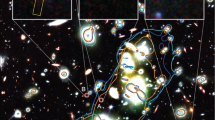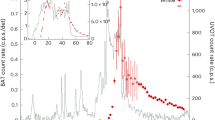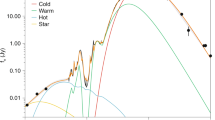Abstract
The extremely red QSO 1413 + 135 shows characteristics typical of BL Lac objects—no emission lines, is embedded in a luminous galaxy, is subject to rapid radio and IR variability, has an inverted radio spectrum and shows substantial IR polarization. The rapid steepening of the nonthermal spectrum at λ < 5 µm is interpreted as synchrotron emission from an electron distribution that ends sharply at some maximum energy. The X-ray emission is probably inverse Compton radiation. We calculate that the optically thin emitting region is compact, has a large magnetic field and exhibits bulk relativistic motion towards the observer. The most energetic electrons in the emitting region have a Lorentz factor of 102–103.
This is a preview of subscription content, access via your institution
Access options
Subscribe to this journal
Receive 51 print issues and online access
$199.00 per year
only $3.90 per issue
Buy this article
- Purchase on Springer Link
- Instant access to full article PDF
Prices may be subject to local taxes which are calculated during checkout
Similar content being viewed by others
References
Boksenberg, A., Carswell, R. F. & Oke, J. B. Astrophys. J. Lett. 206, L121–L124 (1976).
Rieke, G. H., Lebofsky, M. J. & Kinman, T. D. Astrophys. J. Lett. 232, L151–L154 (1979).
Smith, H. E. & Spinrad, H. Astrophys. J. 236, 419–429 (1980).
Beichman, C. A. et al. Nature (in the press).
Rieke, G. H. & Low, F. J. Astrophys. J. 184, 415–426 (1973).
Lebofsky, M. J. IAU Symp. 96, 348 (1981).
Beichman, C. A. et al. Astrophys. J. (in the press).
Kemp, J. C., Rieke, G. H., Lebofsky, M. J. & Coyne, G. V. Astrophys. J. Lett. 215, L107–L110 (1977).
Rieke, G. H. & Lebofsky, M. J. IAU Symp. 92, 263–268 (1980).
Hoskins, D. G., Murdoch, H. S., Hazard, C. & Jauncey, D. L. Aust. J. Phys. 25, 559–593 (1972).
Condon, J. J., Hicks, P. D. & Jauncey, D. L. Astr. J. 82, 692–708 (1977).
Tolbert, C. R. Astr. Astrophys. Supl. 3, 349 (1972).
Ku, W. H.-M., Helfand, D. J. & Lucy, L. B. Nature 288, 323–328 (1980).
Zamorani, G. et al. Astrophys. J. (in the press).
Aller, H. D. Astrophys. J. 161, 1–18 (1970).
Aller, H. D., Aller, M. F. & Hodge, P. E. Astr. J. 86, 325–334 (1981).
Kellermann, K. I. & Pauliny-Toth, I. I. K. A. Rev. Astr. Astrophys. 6, 417–448 (1968).
Angel, J. R. P. & Stockman, H. S. A. Rev. Astr. Astrophys. 18, 321–361 (1980).
Kardashev, N. S. Soviet Astr. 6, 317–327 (1962).
Westfold, K. C. Astrophys. J. 130, 241–258 (1959).
Jones, T. W., O'Dell, S. L. & Stein, W. A. Astrophys. J. 188, 353–368 (1974).
Jones, T. W., O'Dell, S. L. & Stein, W. A. Astrophys. J. 192, 261–278 (1974).
Author information
Authors and Affiliations
Rights and permissions
About this article
Cite this article
Bregman, J., Lebofsky, M., Aller, M. et al. Multifrequency observations of the red QSO 1413 + 135. Nature 293, 714–717 (1981). https://doi.org/10.1038/293714a0
Received:
Accepted:
Issue Date:
DOI: https://doi.org/10.1038/293714a0
This article is cited by
-
Short-timescale variability of the blazar Mrk 421 from AstroSat and simultaneous multi-wavelength observations
Journal of Astrophysics and Astronomy (2021)
-
Radio spectral index of BL Lac objects
Science China Physics, Mechanics and Astronomy (2013)
-
Role of general relativity in accretion disk dynamics
Pramana (1991)
-
Continuum radiation from active galactic nuclei
The Astronomy and Astrophysics Review (1990)
Comments
By submitting a comment you agree to abide by our Terms and Community Guidelines. If you find something abusive or that does not comply with our terms or guidelines please flag it as inappropriate.



